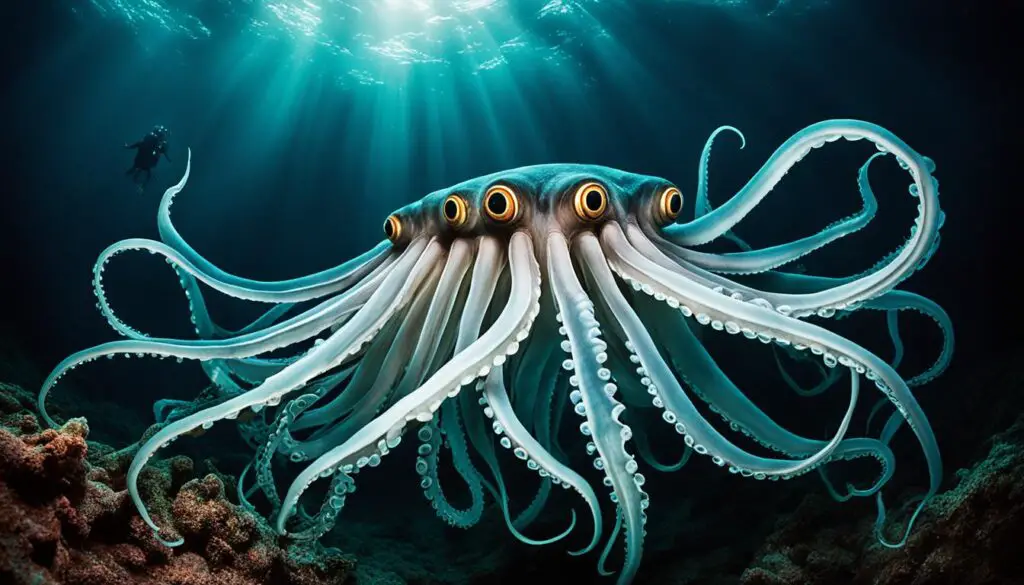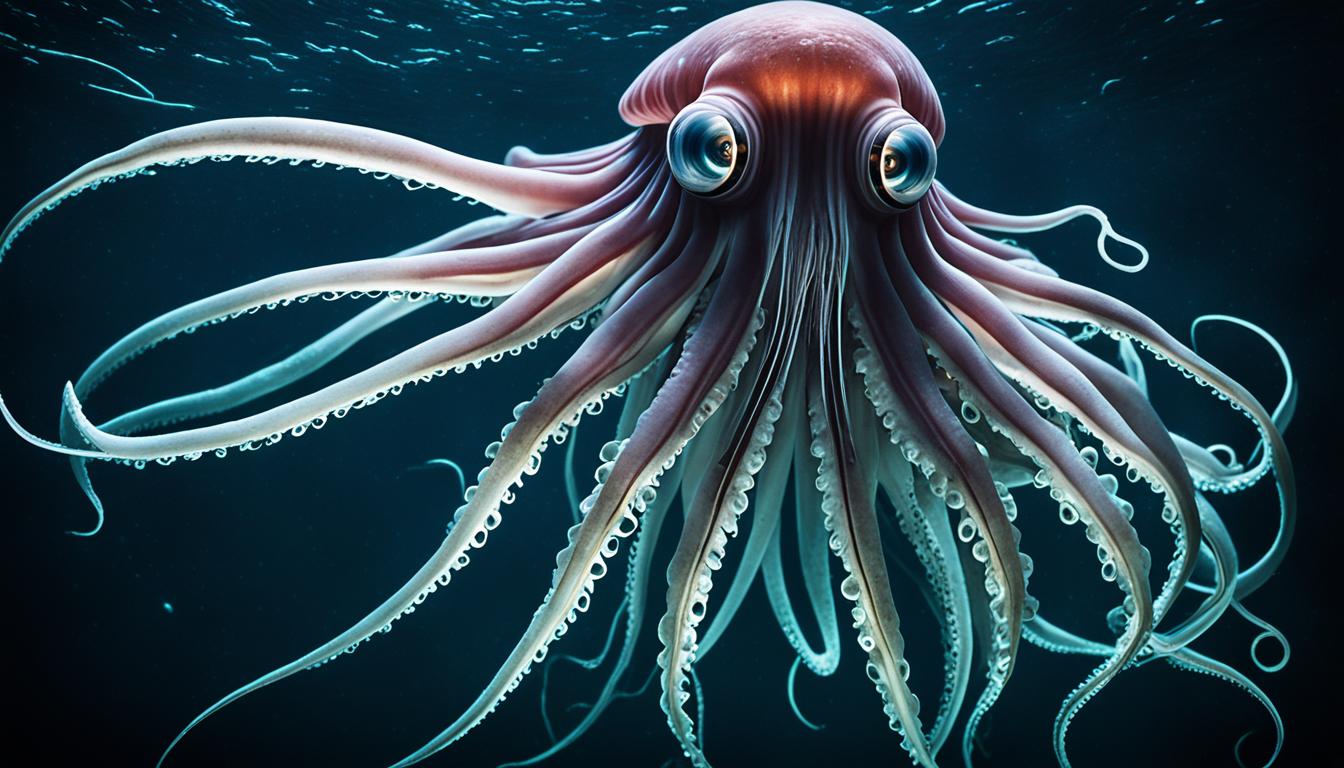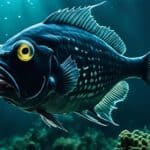Giant squids, known as Architeuthis dux, are amazing creatures living in the deep sea. They have special ways to survive in this tough place. Let’s explore how their size, anatomy, and behaviors help them thrive.
These adaptations make giant squids fascinating to study. By learning about their skills, we understand their importance in the deep-sea world. They show us how they move, hunt, and avoid predators in the dark ocean.
Anatomy of the Giant Squid
The anatomy of the giant squid shows a design that fits perfectly with their life in the sea. It helps us understand how they survive in deep waters.
Body Structure and Size
The giant squid’s body is made up of a long mantle, eight strong arms, and two long tentacles. These tentacles can stretch up to 33 feet long, helping the squid catch food from far away. They can grow up to 43 feet long, with some even bigger. The mantle is about 6.5 feet long, making it easy for the squid to move through the water.
Feeding Tentacles
The feeding tentacles have suckers with tiny teeth, about 2 inches wide. This helps the squid grab and hold onto its food. The squid’s body and tentacles work together for effective feeding in the deep sea.
| Feature | Measurement |
|---|---|
| Max Tentacle Length | 33 feet (10 meters) |
| Max Total Length | 43 feet (13 meters) |
| Typical Mantle Length | 6.5 feet (2 meters) |
| Sucker Width | 2 inches |
How do giant squids adapt to deep-sea environments?
The deep sea is a tough place, with its darkness and vastness. Giant squids have amazing ways to survive here. They have big eyes and special ways to move, which are key for living deep in the ocean.
Large Eyes for Low Light Conditions
Giant squids have some of the biggest eyes in the animal world, up to 12 inches wide. These huge eyes help them catch as much light as possible, which is crucial in the dim deep sea. They can see bioluminescent creatures, which are both food and potential dangers. Their eyes help them move through the dark waters, letting them quickly spot threats or find food.
Jet Propulsion and Locomotion
Giant squids also use jet propulsion to move fast and smoothly. They push water out of their body through a siphon, which lets them swim quickly. This way, they can chase prey or avoid predators easily. With their sharp vision and jet propulsion, giant squids are well-equipped to handle the deep sea.
Feeding Adaptations of Giant Squids
Giant squids are top predators in the deep sea. They have special ways to hunt and eat. This helps them survive in their dark, deep home.
Diet and Hunting Strategy
Giant squids eat deep-sea fish and other squids. This shows their important role in the ocean’s food chain. They have a clever way to catch prey. They use long tentacles to grab food from far away.
Use of Suckers and Beak
After catching prey, giant squids use suckers with sharp teeth to hold it in place. Then, their strong beak helps break the food into smaller bits. This is how they eat efficiently in the deep sea.
| Feeding Adaptations | Description |
|---|---|
| Long Feeding Tentacles | Allows squids to launch towards and capture prey from a distance. |
| Sharp-Toothed Suckers | Enables secure handling of captured prey. |
| Powerful Beak | Breaks down food into smaller pieces for efficient digestion. |
| Radula | Aids in the further disintegration of food material. |
Behavioral Adaptations in the Deep Sea
Giant squids have amazing ways to survive in the deep sea. They have special traits that help them live in this tough place. Their hunting and defense skills are key to their survival.
Solitary Hunting
Giant squids hunt alone, which is a smart move. This lets them sneak up on their prey. They can move quietly in the dark, increasing their chances of catching fish and other sea creatures.
Defensive Mechanisms
Defense is crucial for giant squids. They can release dark ink to confuse predators. This ink acts like a smoke screen, helping them get away from danger. Even though they’re big, they still have to watch out for predators like sperm whales.

| Behavioral Adaptation | Description | Purpose |
|---|---|---|
| Solitary Hunting | Stalking prey alone in deep waters | Enhances ambush success |
| Expelling Ink | Creating a smokescreen to evade predators | Facilitates escape from threats |
| Large Size | Size deters smaller marine threats | Provides a competitive advantage |
Growth and Reproductive Strategies
The giant squid has unique ways of growing and reproducing that help it survive in the deep sea. These strategies are key to keeping their numbers up. By understanding how they grow and reproduce, we can see what makes them successful in the ocean.
Lifecycle and Maturation
Giant squids grow fast, reaching lengths over 30 feet in just a few years. They become adults around three years old and follow a semelparous lifecycle. This means they reproduce only once before they die. Females lay millions of eggs in a jelly-like mass, showing how important reproduction is to them.
Reproductive Behavior
During mating, the male transfers spermatophores directly to the female’s arms. This shows how adaptable giant squids are in reproduction. After mating, the female carries the fertilized eggs until it’s time to release them into the water. This shows how crucial growth and reproduction are for them to survive in the deep sea.
Ecological Role in the Deep-Sea Environment
Giant squids are crucial in the deep-sea as top predators. They play a key role in the giant squid ecosystem. By eating different fish and squids, they keep populations in check. This helps maintain a balanced food web in the ocean.
This predatory behavior affects the health of the ocean. It shows how important giant squids are for keeping the ecosystem balanced.
Giant squids also feed other marine animals, like sperm whales. This shows they are vital in the ocean’s food chain. Knowing their role helps us understand the deep-sea better and why we should protect these habitats.
Looking at giant squids’ role in the ocean shows us the deep sea’s biodiversity. Their interactions with other sea creatures show the fine balance of ocean life. Highlighting their role helps us appreciate the deep-sea’s complex and delicate nature.
FAQ
How do giant squids adapt to deep-sea environments?
Giant squids have big eyes to see in the dark, a special way to move fast, and a body shape for hunting. These features help them live in deep-sea places.
What is the anatomy of a giant squid?
Giant squids have a simple body with a mantle, eight arms, and two long tentacles. They can grow up to 43 feet long, with tentacles up to 33 feet long.
How do giant squids feed and hunt?
They eat deep-sea fish and other squids with their long tentacles. They have suckers with sharp teeth and a beak to catch and eat their food.
What adaptations do giant squids have for low-light conditions?
Their eyes are huge, about 12 inches wide, helping them see in the dark. This lets them find prey and avoid dangers in deep ocean depths.
How do giant squids move in deep-sea environments?
They use jet propulsion to move fast. They push water out of their body to move forward, helping them hunt or escape danger.
Are giant squids solitary hunters?
Yes, they hunt alone, which helps them catch hard-to-find prey in deep water.
What defensive mechanisms do giant squids possess?
They can release dark ink to confuse predators and use their size to scare off smaller threats. But, they can’t always protect themselves from big predators like sperm whales.
How do giant squids grow and reproduce?
They grow fast, reaching over 30 feet in a few years, and mature at about three years old. They lay millions of eggs and only reproduce once in their life.
What is the ecological role of giant squids in their environment?
As top predators, giant squids are key to the ocean’s food chain. They eat many fish and squids, affecting their populations in deep-sea ecosystems.







